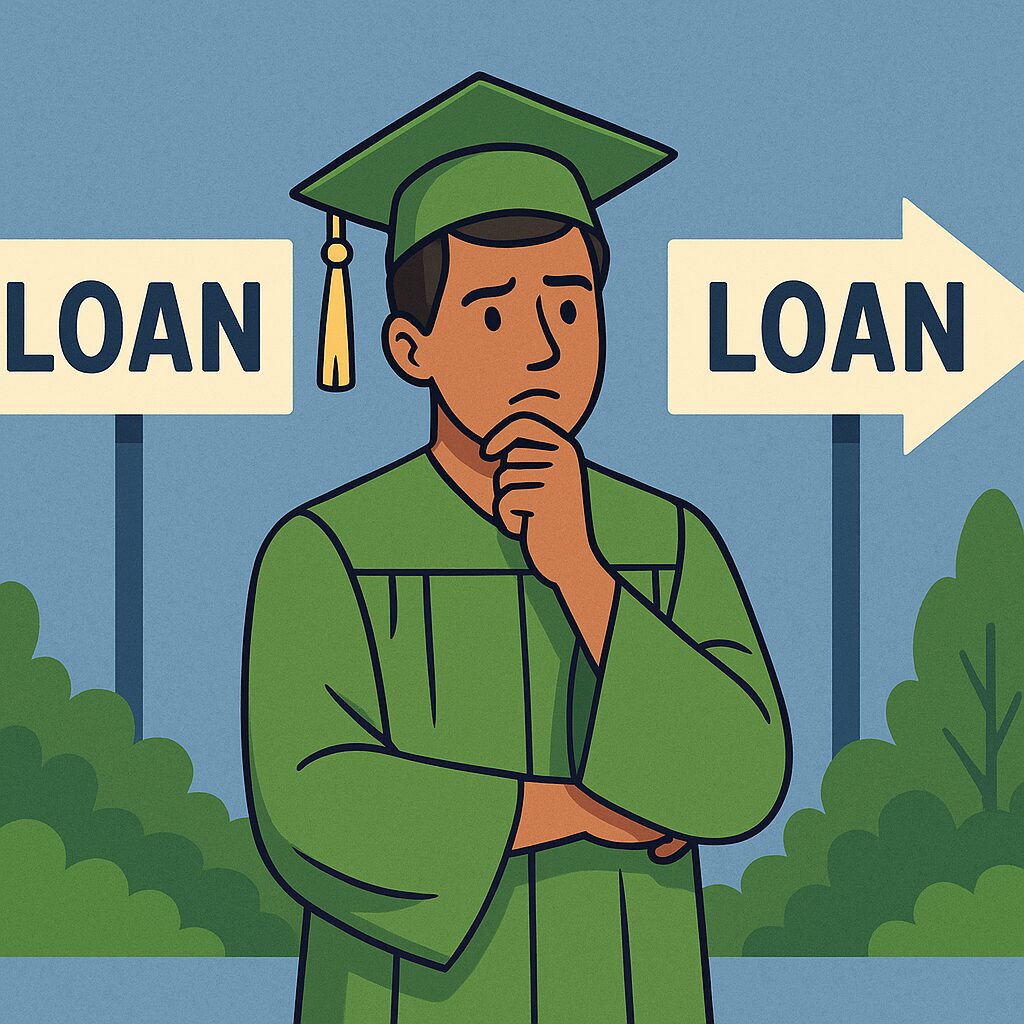Graduate and professional students face big decisions—not only about programs and career paths, but also about how to finance them. Choosing the best loan for grad school is not one-size-fits-all. The way you fund your education—whether through scholarships, fellowships, federal aid, or loans—can profoundly shape your future. Done right, your plan can be manageable, sustainable, and adaptable as your career evolves.
Below is a practical roadmap to help you evaluate your options.
Your graduate education is a powerful investment in yourself, but the debt you take on should remain manageable and never define your future. By planning ahead and choosing a loan structure that is attainable, adaptable, and repayable, you can pursue your goals with confidence—positioning yourself for professional success while keeping financial stress in check.

Start with Gift Aid and School Resources
Before borrowing, maximize the funding you don’t need to repay:
- Scholarships, fellowships, and assistantships remain the most desirable forms of support. They make your education affordable without creating debt.
- Many schools offer graduate financial aid packages that include need-based grants or school-specific loan funds. For example, Harvard Law School’s Low Income Protection Plan helps JD graduates manage repayment burdens responsibly. Other institutions like Stanford Graduate School of Business emphasize fellowships first to reduce reliance on loans.
Federal Direct Unsubsidized Loans: Your First Borrowing Option
Graduate and professional students are eligible for up to $20,500 per year in Federal Direct Unsubsidized Loans. These loans are:
- Available without a credit check, making them more inclusive.
- Predictable, with fixed interest rates set by Congress.
- Manageable, since they usually carry lower interest rates than federal Grad PLUS or private loans.
Both the U.S. Department of Education and nonprofit guides like The Institute for College Access & Success (TICAS) consistently advise students to maximize unsubsidized loans first before turning to costlier borrowing.
Federal Grad PLUS Loans: Useful but Time-Limited
Federal Grad PLUS Loans can fill the gap between your cost of attendance and other aid. They are:
- Flexible, covering tuition, fees, and living costs.
- Accessible, though they do require a credit check.
- Valuable—but pricier, with higher interest rates and fees than unsubsidized loans.
If you plan to use them, be aware that the Federal Grad PLUS program will be eliminated after July 1, 2026 (per studentaid.gov). Until then, they remain a viable option, but use them strategically.
Understand Interest Rates, Fees, and Borrower Benefits
When comparing loan options, focus on these key factors:
- Interest rates: Federal loans have fixed rates; private lenders may offer variable rates that seem lower upfront but can climb over time as well as fixed rates.
- Fees: Origination fees apply to Federal Grad PLUS loans, while private loans may have low to none.
- Borrower benefits: Federal loans include protections like deferment, forbearance, and income-driven repayment. Some private lenders also offer borrower benefits like interest rate discounts for autodebit, co-signer release options, advertise refinance-able or forgivable perks, but these vary widely.
- Repayment flexibility: Loan program repayment lengths may also be adaptable to your circumstances. Federal loans typically come with a standard 10-year repayment plan, though graduate and professional students can extend payments up to 20–25 years through repayment plans options. This longer timeline can make monthly payments more manageable early in your career, but also increases the total interest you’ll pay over time. Some universities even offer loan repayment assistance programs (LRAPs)—for example, Yale Law School and Harvard Kennedy School help graduates in public service careers keep repayment sustainable. Private student loans, by contrast, often offer repayment terms ranging from 5 to 20 years, but with less flexibility to adjust as your circumstances change. The right repayment length is one that balances affordability now with a realistic plan to become debt-free in the future.
Weighing Private Student Loans
Private loans should be a last resort. Nonprofit advisors like the National Foundation for Credit Counseling (NFCC) caution that private loans lack the protections of federal aid. That said, they can be:
- Attainable when federal limits aren’t enough.
- Customizable if you find a lender with competitive borrower benefits.
- Often co-signer-dependent, which may or may not be workable depending on your family or financial support system.
If you consider private loans:
- Compare interest rates (fixed vs. variable).
- Review repayment terms, co-signer release options, and borrower protections.
Borrow Strategically and Responsibly
Remember, loans are a tool—not free money. Keep your borrowing:
- Sustainable by covering only what you need.
- Predictable by making a repayment plan early.
- Manageable by exploring income-driven repayment or refinance options once you graduate.
Your education is an investment, but debt should not overwhelm your future. With careful planning, you can choose a loan structure that’s attainable, adaptable, and repayable—setting you up for professional success without financial regret.
Loan Features & Preferences Survey
This 5-question survey captures what students value most in a graduate student loan. We’ll ask about preferred repayment structures, interest rates, borrowing limits, and flexibility.
Results will be summarized and shared back on the site so the student community can see which features matter most collectively—information that can also help shape the kinds of solutions schools, policymakers, and future lenders prioritize.

Leave a Reply